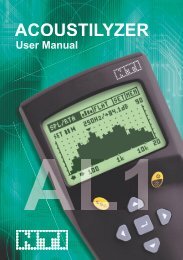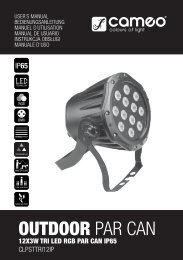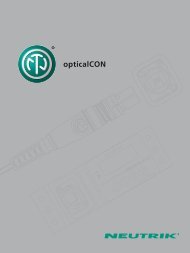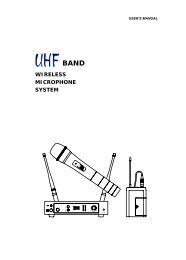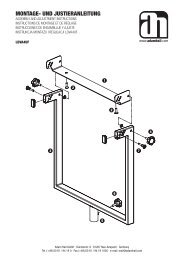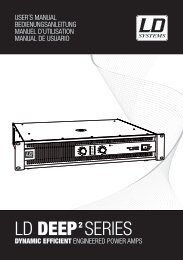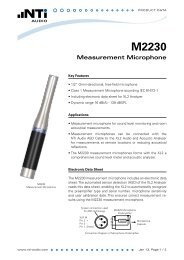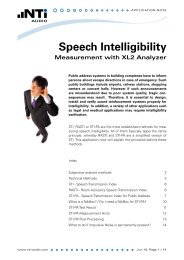OpticalCon
OpticalCon
OpticalCon
You also want an ePaper? Increase the reach of your titles
YUMPU automatically turns print PDFs into web optimized ePapers that Google loves.
<strong>OpticalCon</strong> ®<br />
Fiber Optic Connection System<br />
Authors:<br />
Neutrik AG<br />
Im alten Riet 143<br />
9494 Schaan<br />
Liechtenstein<br />
Projekt: <strong>OpticalCon</strong> ®<br />
Version: 3<br />
Pages: 29
Subject:<br />
Mechanical, electrical and optical tests applied to the <strong>OpticalCon</strong> ® transmission system<br />
for Pro Audio / Video industry purposes with main focus on changes in attenuation.<br />
Optical performance is being examined with regard to attenuation and its variation vs.<br />
environmental and mechanical conditions.<br />
This documentation describes the results of the test series conducted at Neutrik AG,<br />
University of Applied Sciences of Technology Buchs NTB and Electrosuisse-Fehraltorf<br />
(SEV Association for Electrical Engineering, Power and Information Technologies).<br />
The tests were carried out in accordance with the IEC-Standard main groups IEC 60794<br />
and IEC 61300 as well as to Neutrik internal specifications.<br />
Technical Paper <strong>OpticalCon</strong> 2
Content of Test Reports<br />
1 Optical Attenuation................................................................................................4<br />
2 Vibration................................................................................................................6<br />
3 Cable Retention ....................................................................................................9<br />
4 Locking mechanism ............................................................................................10<br />
5 Impact .................................................................................................................11<br />
6 Mating Durability .................................................................................................13<br />
7 Change of Temperature......................................................................................15<br />
8 Flexing ................................................................................................................17<br />
9 Dust ....................................................................................................................20<br />
10 Sealing Gasket ...................................................................................................23<br />
11 Cable Drum.........................................................................................................24<br />
12 Contact Resistance.............................................................................................25<br />
13 Dielectric Strength...............................................................................................26<br />
14 Insulation Resistance..........................................................................................27<br />
15 Current Capacity.................................................................................................28<br />
Attachment: Cable specifications...................................................................................29<br />
Technical Paper <strong>OpticalCon</strong> 3
1 Optical Attenuation<br />
Object:<br />
Examination of the receptacle NO2-4FD in combination with the <strong>OpticalCon</strong> ® cable<br />
connector to determine the attenuation in a fiber optic system.<br />
For the test of the cable connector a completely assembled <strong>OpticalCon</strong> cable was used.<br />
See fig. 1.<br />
Test Set-Up:<br />
Test specimens:<br />
Single mode:<br />
Multi mode:<br />
NKO2SA-0-2 (2 m length)<br />
NKO2M-0-1 (1 m length)<br />
Test procedure according to IEC 61300-3-4 figure 4 with mode filter described in table 3<br />
for multi mode, for single mode no mode filter was used.<br />
Test equipment: light source EXFO FLS-600<br />
power meter EXFO FPM-600<br />
Launching cables:<br />
Reference complex:<br />
0.9 mm precision fibres<br />
precision adapter FLC-FLC<br />
Measuring wave lengths: Single mode<br />
Multi mode<br />
1,310 nm<br />
850 nm<br />
Cable length: Single mode 2 m<br />
Multi mode 1 m<br />
Comment:<br />
Short cable lengths do not affect attenuation remarkably and<br />
are therefore not considered.<br />
Technical Paper <strong>OpticalCon</strong> 4
1 Optical Attenuation (contd.)<br />
Fig. 1: Simplified measuring arrangement<br />
Limit Values (per mating pair):<br />
Single mode:<br />
Multi mode:<br />
0.5 dB<br />
0.35 dB<br />
Results:<br />
Basis of test series: 50 sets of cable assemblies<br />
Single mode:<br />
Multi mode:<br />
0.10 – 0.44 dB<br />
0.08 – 0.32 dB<br />
Technical Paper <strong>OpticalCon</strong> 5
2 Vibration<br />
Object:<br />
Examination of the two components, receptacle NO2-4FD and the <strong>OpticalCon</strong> ® cable<br />
connector. The intention of the test was to determine their attenuation in a fiber optic<br />
system before, during and after the vibration test.<br />
In addition the test presents the change in contact resistance of the electrical contacts<br />
as well as the function of the mechanical locking system and the wear.<br />
The test was carried out by an independent laboratory: NTB, "Interstaatliche<br />
Hochschule für Technik Buchs" division "Labor Mess- und Simulationstechnik" located<br />
in Buchs/ Switzerland.<br />
Test Set-Up:<br />
For the vibration test two receptacles NO2-4FD per axis were mounted. The front side<br />
was mated with a NKO2M-4S75-0-1 <strong>OpticalCon</strong> cable. The rear end was connected<br />
with the test instrument via precision measuring cables (see fig. 2a/b).<br />
The applied test set-up complies with IEC 61300-2-1 table 1.<br />
Shaker:<br />
TIRAVIB Model 5200, controlled by an external<br />
power amplifier and a PC with software VibeLab-Pro<br />
(fig. 2 a/b).<br />
Test instruments: light source EXFO FLS-600<br />
power meter EXFO FPM-600<br />
Launching cables:<br />
0.9 mm precision fibres, assembled by H&S<br />
Measuring wave lengths: single mode<br />
multi mode<br />
1,310 nm<br />
850 nm<br />
DUT cable length: single mode 2 m<br />
multi mode 1 m<br />
Comment:<br />
Short cable lengths do not affect attenuation remarkably and<br />
are therefore not considered.<br />
Technical Paper <strong>OpticalCon</strong> 6
2 Vibration (contd.)<br />
Vibration Severity:<br />
Frequency range: 10 – 55 Hz sinusoidal<br />
Amplitude displacement: 1.52 mm (3.04 mm p-p)<br />
Acceleration: up to 20 g (200 m/s 2 )<br />
Sweep rate:<br />
2 min/cycle<br />
Number of sweeps: 15<br />
Axis:<br />
X, Y, Z<br />
After 15 cycles the receptacles were changed to the next axis without disconnecting the<br />
pugs to avoid any mismatching.<br />
Results:<br />
Attenuation before, during and after vibration test:<br />
Changes in attenuation:<br />
Single mode: - 0.08 dB to - 0.03 dB<br />
Multi mode: - 0.03 dB to + 0.13 dB<br />
The reason for the attenuation improvement compared to the initial values may result<br />
from new positioned ferrules as a result of vibration.<br />
Measurement during vibrations showed no variation in attenuation.<br />
Electrical Contact Resistance<br />
The contact resistance has changed from 4.6 mΩ average to 4.7 mΩ per contact.<br />
Mechanical<br />
The locking mechanism withstands this extreme vibration without any problems, i. e. no<br />
separation or functional deteriorization occurred.<br />
Technical Paper <strong>OpticalCon</strong> 7
2 Vibration (contd.)<br />
Fig. 2a: Vibration equipment and test cable arrangement<br />
Fig. 2b: Vibration equipment and test cable arrangement<br />
Technical Paper <strong>OpticalCon</strong> 8
3 Cable Retention<br />
Object:<br />
Test of the cable retention efficiency. The <strong>OpticalCon</strong> cables NKO* were exposed to<br />
tractive forces until the cable started to move.<br />
Test Set-Up:<br />
The applied test procedure is referred to IEC 61300-2-4.<br />
Tension-Tester:<br />
Measuring Instruments:<br />
Assembled cable types:<br />
Versa Test Mecmesin 0-1,000N<br />
(fig. 3)<br />
AFG-R 1000N Mecmesin<br />
NKO2M-0-1 multi mode 2 fibers<br />
NKO2M-4S75-0-1 multi mode 2 fibers and 4 copper wires<br />
NKO2SA-0-1 single mode 2 fibers<br />
NKO2SA-S1-0-1 (SMPTE) single mode 2 fibers<br />
and 4 copper wires<br />
Results:<br />
NKO2M-0-1 multi mode 2 fibers<br />
> 500N<br />
NKO2M-4S75-0-1 multi mode 2 fibers and<br />
4 copper wires > 500N<br />
NKO2SA-0-1 single mode 2 fibers<br />
> 500N<br />
NKO2SA-S1-0-1 (SMPTE) single mode 2 fibers and<br />
4 copper wires > 350N<br />
Fig. 3: Equipment for examination of cable retention<br />
Technical Paper <strong>OpticalCon</strong> 9
4 Locking Mechanism<br />
Object:<br />
Tensile strength measurement of the locking mechanism.<br />
Test Set-Up:<br />
Same test set-up as used in clause 3. Cable Retention. Instead of the cable a<br />
mechanical adapter was used to fix the plug.<br />
Results:<br />
Tensile strength > 1,000N<br />
At a force of 1,000N the test was stopped without any damages of the locking device.<br />
Technical Paper <strong>OpticalCon</strong> 10
5 Impact<br />
Object:<br />
The impact test is performed to show possible deformations or plug malfunction of the<br />
internal mechanism due to heavy mechanical exposure.<br />
Test Set-Up:<br />
The applied test procedure is referred to the IEC 61300-2-12 Method A pendulum drop<br />
(fig. 4).<br />
Test item:<br />
First part of test:<br />
Second part of test:<br />
<strong>OpticalCon</strong> ® cable connector<br />
front side of connector protected by a protection cap of<br />
EPDM (protection cap is supplied with each cable drum)<br />
no connector protection<br />
Parameters of Test:<br />
Distance from centre of rotation: 2.25 m<br />
Number of drops: 5<br />
Height of falling:<br />
1.0 – 1.9 m<br />
Ground:<br />
steel plate, thickness 25 mm<br />
Plug fixation:<br />
small wire<br />
Results:<br />
Tests 1 – 3 no visible abrasions, no functional problems<br />
Test 4<br />
minimal abrasions at the edge of the plug, but no functional problems<br />
Technical Paper <strong>OpticalCon</strong> 11
5 Impact (contd.)<br />
Fig. 4: Test set-up "Impact"<br />
Test # with cap<br />
drop height<br />
m<br />
drops comment<br />
1 yes 1.0 5<br />
2 yes 1.9 5<br />
result<br />
no visible abrasion full<br />
function<br />
no visible abrasion full<br />
function<br />
3 yes 1.0 5<br />
4 no 1.5 5<br />
extremely manual<br />
acceleration<br />
valuation after each<br />
drop<br />
no visible abrasion full<br />
function<br />
minimum abrasion full<br />
function<br />
Table 1: Impact test IEC 61300-2-12 method A<br />
Technical Paper <strong>OpticalCon</strong> 12
6 Mating Durability<br />
Object:<br />
The mating durability test was carried out to show variations in attenuation (optical) and<br />
of electrical contact resistance after lifetime.<br />
Test specimens:<br />
NKO2M-0-1 multi mode 2 fibres<br />
NKO2SA-0-1 single mode 2 fibres<br />
NKO2SA-S1-0-1 (SMPTE) single mode 2 fibres and<br />
4 copper wires<br />
Test Set-Up:<br />
Test procedure according to IEC 61300-2-2 in combination with IEC 61300-3-4 figure 4<br />
with mode filter as defined in table 3 for multi mode, no mode filter for single mode.<br />
Contact resistance measurement according to IEC 60512-2.<br />
The test was realized with the equipment shown in fig. 5.<br />
Mating cycles: 1,000<br />
Launching: light source EXFO FLS-600<br />
power meter EXFO FPM-600<br />
Microscope: enlarged x 200<br />
Measuring cables:<br />
0.9 mm precision fibres, assembled by H&S<br />
Measuring wave lengths: single mode<br />
multi mode<br />
1,310 nm<br />
850 nm<br />
DUT cable length: single mode 1 m<br />
multi mode 1 m<br />
Results:<br />
The microscopic assay didn’t show any reasonable degradation. The attenuation values<br />
still fulfill Neutrik’s internal requirements of < 0,5 dB/connection.<br />
Multi mode: 0.17 dB degradation without cleaning, 0.08 dB degradation after cleaning<br />
Single mode: 0.45 dB degradation without cleaning, 0.25 dB degradation after cleaning<br />
The test results of the electrical contacts are handled in chapter 11.<br />
Technical Paper <strong>OpticalCon</strong> 13
6 Mating Durability (contd.)<br />
Fig. 5: Test facility for mating durability<br />
Microscopic inspection:<br />
Channel 1 multi mode:<br />
no visable degradation<br />
Channel 2 multi mode:<br />
harmless degradation<br />
Channel 1 single mode:<br />
no visable degradation<br />
Channel 2 single mode:<br />
harmless degradation<br />
Technical Paper <strong>OpticalCon</strong> 14
7 Change of Temperature<br />
Object:<br />
Variations in attenuation due to temperature changes.<br />
The test was arranged with a single mode cable drum which is more critical than multi<br />
mode.<br />
Test Set-Up:<br />
Test procedure according to IEC 61300-2-22 in combination with IEC 61300-3-4<br />
figure 4.<br />
The test was realized in a temperature testing chamber type WEISS WK11-180/40.<br />
Test cycles:<br />
16 (96h)<br />
Profile of temperature: -25°C to +75°C (fig. 6)<br />
Test instruments: light source EXFO FLS-600<br />
power meter EXFO FPM-600<br />
Launching cables:<br />
0.9 mm precision fibers, constantly connected with the DUT<br />
(device under test) through a hole in the test camber.<br />
Measuring wave lengths: single mode at 1,310 nm<br />
Cable length:<br />
Test specimen:<br />
300 m<br />
NKO2SA-3-300<br />
Results:<br />
Maximum increase in attenuation 0.42 dB over the whole temperature range.<br />
Technical Paper <strong>OpticalCon</strong> 15
7 Change of Temperature (contd.)<br />
Fig. 6: Profile of temperature<br />
Technical Paper <strong>OpticalCon</strong> 16
8 Flexing<br />
Object:<br />
Variations of attenuation and mechanical damage of fiber optic cable due to a defined<br />
flexing procedure.<br />
Assembled cable types:<br />
NKO2M-0-1 Multi mode 2 fibres<br />
NKO2SA-0-1 Single mode 2 fibres<br />
NKO2SA-S1-0-1 (SMPTE) Single mode 2 fibres and<br />
4 copper wires<br />
Test Set-Up:<br />
Measurement of attenuation before, during and after flexing cycles.<br />
Test procedure according to IEC 61300-2-44 in combination with IEC 61300-3-4 figure 4<br />
with mode filter as defined in table 3 for multi mode, no mode filter for single mode.<br />
Test equipment: fig. 7 and 8<br />
Test cycles: 1,000 / 5,000<br />
Mass of weight:<br />
10 N or 20 N depending on cable type<br />
Flexing angle: ± 90°<br />
Flexing speed:<br />
ca. 12 cycles/min<br />
Test Instruments: light source EXFO FLS-600<br />
power meter EXFO FPM-600<br />
Launching cables:<br />
0.9 mm precision fibers, assembled by H&S<br />
Measuring wave lengths: single mode<br />
multi mode<br />
1,310 nm<br />
850 nm<br />
DUT cable length: single mode 1 m<br />
multi mode 1 m<br />
Technical Paper <strong>OpticalCon</strong> 17
8 Flexing (contd.)<br />
Results:<br />
a) Change in attenuation:<br />
Single mode<br />
Multi mode<br />
0.05 dB to 0.20 dB<br />
0.00 dB to 0.03 dB<br />
b) Mechanical cable damage:<br />
1,000 cycles: no damage<br />
5,000 cycles: no significant damage, single strands (AWG 16) of SMPTE cable<br />
partly broken<br />
Fig. 7: Principle of Test according to IEC 61300-2-44 (IEC 61300-3-4)<br />
Technical Paper <strong>OpticalCon</strong> 18
8 Flexing (contd.)<br />
Fig. 8: Test Equipment and Fixture for flexing test<br />
Technical Paper <strong>OpticalCon</strong> 19
9 Dust<br />
Object:<br />
Variations of attenuation due to massive dust penetration. The test was carried out with<br />
single mode cables where soiling of the connecting surface effects much more<br />
attenuation than at multi mode cables.<br />
The test was carried out by an independent laboratory: Electrosuisse, test laboratory<br />
PQ/PIK in 8320 Fehraltorf, Switzerland.<br />
Test Set-Up:<br />
The <strong>OpticalCon</strong> connector was exposed to dust from both sides in wired condition for<br />
60 minutes. The built-in sealing shutters protected the optical conductor at the front<br />
side, the plugged-in LC-Duplex connectors shielded the rear side.<br />
Test procedure according to IEC 61300-2-27 in combination with IEC 61753-1-1 Tab.<br />
A5 Test No.16 and IEC 61300-3-4 figure 4.<br />
Test specimen:<br />
NO2-4FD - Receptacle<br />
Particle size: d < 150 µm<br />
Dust type:<br />
talcum powder<br />
Temperature: 19°C<br />
Relative humidity: 54%<br />
Duration of penetration:<br />
1 h<br />
Test Instruments: light source EXFO FLS-600<br />
power meter EXFO FPM-600<br />
Launching cables:<br />
0.9 mm precision fibers<br />
Measuring wave lengths: single mode<br />
1,310 nm<br />
DUT cable length: single mode 2 m<br />
Technical Paper <strong>OpticalCon</strong> 20
9 Dust (contd.)<br />
Results:<br />
Attenuation Initial After Contamination<br />
NO2-4FD-R<br />
NO2-4FD<br />
A 0.31 0.34<br />
B 0.36 0.38<br />
A 0.38 0.39<br />
B 0.33 0.36<br />
Table 2: Dust test - attenuation in dB<br />
Channel A was defined as for the front side of the receptacle<br />
The corresponding power level was calibrated at 4.91 dBm @ 1310nm (=0.00dB)<br />
Maximum increase in attenuation: 0.03 dB<br />
The IP rating can be defined with IP 5x.<br />
Fig. 9: Dust sediment on the rear side of the receptacle after 60 min.<br />
Technical Paper <strong>OpticalCon</strong> 21
9 Dust (contd.)<br />
Fig. 10: Dust sediment on the front side of the receptacle after 60 min.<br />
Technical Paper <strong>OpticalCon</strong> 22
10 Sealing Gasket<br />
Object:<br />
Durability test of the sealing cover surface. Long-term load of the closed sealing cover<br />
by a constant laser beam.<br />
The intention is to find out if the silicon layer alters or a deposition is formed on the fiber<br />
surface of the connector.<br />
Test Set-Up:<br />
An interconnection was inserted into a chassis connector type NO2-4FD from the rear.<br />
The fiber surface of the interconnection had direct contact to the cover surface.<br />
The second end of the interconnection was connected to a light source.<br />
See fig. 4<br />
Light source: EXFO FLS-600<br />
Power meter: EXFO FPM-600<br />
Test parameter: Wavelength: 1310nm<br />
Output power: 4.6dBm (referenced 0dB)<br />
Duration: 12h<br />
Result:<br />
No difference between referencing and measuring after the duration of test: ± 0dB.<br />
The surfaces of the fiber and the gasket as well showed no mechanical variation in the<br />
area of the fiber contact (checked by microscope).<br />
Fig. 4: Test Set-Up<br />
Technical Paper <strong>OpticalCon</strong> 23
11 Cable Drum<br />
Object:<br />
Variations of attenuation due to winding quality on cable drums.<br />
First part of the test:<br />
Second part of test:<br />
Third part of the test:<br />
attenuation measurement of perfectly wounded drum<br />
attenuation measurement of unwinded cable<br />
spooling of the cable drum in a typical on stage manner,<br />
i. e. with a lot of crossed cable windings; attenuation<br />
measurement<br />
Test Set-Up:<br />
Test procedure according to chapter 1 Attenuation.<br />
Parameters:<br />
Drum assembly:<br />
Cable length:<br />
Wave length:<br />
NKO2SA-3-1000 - single mode 2 x 9/125µm<br />
1,000 m<br />
1,310 nm<br />
Results:<br />
First test (spooled cable drum): attenuation initial channel A: 0.34 dB<br />
channel B: 0.37 dB<br />
Second test (unwinded cable drum):<br />
change in attenuation - 0.04 dB to - 0.07dB<br />
Third test (spooled cable drum): increase of initial attenuation + 0.01 dB<br />
to + 0.08 dB<br />
Technical Paper <strong>OpticalCon</strong> 24
12 Contact Resistance<br />
Object:<br />
Initial value and variation of contact resistance.<br />
<strong>OpticalCon</strong> ® cable connector mated with the receptacle NO2-4FD before and after<br />
1,000 mating cycles.<br />
Test Set-Up:<br />
Test procedure according to IEC 60512-2 test 2a<br />
Measuring Instrument: HIOKI – 3540 Millivoltmeter<br />
Results:<br />
Contact Resistance<br />
[mΩ]<br />
initial<br />
measured<br />
average value<br />
4.6<br />
conditional value<br />
6.0<br />
after 1,000 cycles<br />
5.7<br />
7.0<br />
Technical Paper <strong>OpticalCon</strong> 25
13 Dielectric Strength<br />
Object:<br />
Same test set-up as used in clause 11 Contact Resistance. It was checked in<br />
completely mated, half mated and unmated condition. Each combination of<br />
contact to contact and contact to shell was judged.<br />
Test Set-Up:<br />
Test procedure according to IEC 60512-2 test 4a<br />
Measuring Instrument:<br />
Test Parameter:<br />
GOR-1 Dielectrometre<br />
0 – 6 kV<br />
The conditional value of dielectric strength was defined with > 1.5 kV.<br />
Results:<br />
Minimum dielectric strength: 2.0 kV<br />
Technical Paper <strong>OpticalCon</strong> 26
14 Insulation Resistance<br />
Object:<br />
Same test set-up as used in clause 11 Contact Resistance.<br />
Test Set-Up:<br />
Test procedure according to IEC 60512-2 Test 3a<br />
Measuring Instrument:<br />
Test Parameter:<br />
METRISO C<br />
maximum measurable isolation resistance 100 GΩ<br />
test voltage 500V DC<br />
The insulation resistance was defined with > 10GΩ.<br />
Results:<br />
Minimum insulation resistance: 64.7GΩ<br />
Technical Paper <strong>OpticalCon</strong> 27
15 Current Capacity<br />
Object:<br />
Temperature rise of contacts as a result of electrical current.<br />
Test Set-Up:<br />
Test procedure according to IEC 60512-5-1 test 5a<br />
Current source:<br />
Measuring Instrument:<br />
VAREG, 3V 0-50 A rms<br />
TESTO 935 Thermometer, 2 channels<br />
-50 - +350°C<br />
The maximum temperature rise was defined generally with < 40K.<br />
The measurements were realized for the following wires and currents:<br />
1 contacts 1-4 wired with 0.22 mm 2 , 6 Amps through all contacts<br />
2 contacts 1+4 wired with 1.5 mm 2 , 10 Amps through both contacts<br />
in case of SMPTE application<br />
3 contacts 1+4 wired with 1.5 mm 2 , 10 Amps through both contacts and additionally<br />
contacts 2+3 wired with 0.22 mm 2 , 1 Amp through both contacts in case of<br />
SMPTE application.<br />
Results:<br />
Ad 1: 26.7K<br />
Ad 2: 23.1K<br />
Ad 3: 28.6K<br />
A rated current of 6 A (10 A for the SMPTE cable) can be defined.<br />
Technical Paper <strong>OpticalCon</strong> 28
Attachment: Cable specifications<br />
2M-4S75 2M 2S (SA) * 2S (SA)-S1 *<br />
number of fibers 2 2 2 2<br />
fiber type multi mode multi mode single mode single mode<br />
Attenuation<br />
2.5 dB/km<br />
@ 850 nm<br />
0.7 dB/km<br />
@ 1,300 nm<br />
3 dB/km<br />
@ 850 nm<br />
1 dB/km<br />
@ 1,300 nm<br />
0.5 dB @ 1,300<br />
nm (1,550 nm)<br />
0.5 dB @ 1,300<br />
nm (1,550 nm)<br />
core diameter 50 µm 50 µm 9 µm 9 µm<br />
cladding<br />
diameter<br />
125 µm 125 µm 125 µm 125 µm<br />
fibre cable<br />
design<br />
tight-buffer tight-buffer tight-buffer tight-buffer<br />
copper wires<br />
4 x AWG 18<br />
(0.75 mm²)<br />
- -<br />
outer shield - - -<br />
2 x AWG 24<br />
2 x AWG 16<br />
copperbraidtinned,<br />
95 %<br />
coverage<br />
strength<br />
1.02 mm<br />
2 mm GFK - -<br />
member<br />
stainless steel<br />
cable retention Aramid yarn Aramid yarn Aramid yarn crimp type<br />
overal diameter 8.9 mm 5 mm 5 mm 9.2 mm<br />
jacket material PUR PUR PUR PVC Belflex®<br />
Color black, matte black, matte black, matte black, matte<br />
min. bending<br />
radius<br />
10 cm 4 cm 4 cm 10 cm<br />
Weight 78 kg/km 23 kg/km 23 kg/km 118 kg/km<br />
operating temp. –20°C to +70°C –55°C to +85°C –55°C to +85°C –30°C to +60°C<br />
crush resistance<br />
200 N/cm 440 N/cm 440 N/cm<br />
1,800 N<br />
IEC 60794-1-2 TIA/EIA-455-41 TIA/EIA-455-41<br />
FOTP-41<br />
E3<br />
mil. requ. mil. Requ.<br />
impact<br />
resistance<br />
flex resistance<br />
o.r.<br />
5,000 cycles<br />
IEC 60794-1-2<br />
E6<br />
200 impacts<br />
EIA/TIA-455-25<br />
mil. requ.<br />
2,000 cycles<br />
TIA/EIA-455-104<br />
mil. requ.<br />
200 impacts<br />
EIA/TIA-455-25<br />
mil. requ.<br />
2,000 cycles<br />
TIA/EIA-455-104<br />
mil. requ.<br />
20 cycles<br />
@1.32 lbs<br />
FOTP-25<br />
1,000 cycles<br />
@ 3.6’’<br />
FOTP-104<br />
15,000 cycles @<br />
tensile strength 1750 N 600 N 600 N o.r.<br />
applicable<br />
standards<br />
- - - SMPTE311M<br />
* S = PC connector surface<br />
SA = APC connector surface<br />
Technical Paper <strong>OpticalCon</strong> 29



